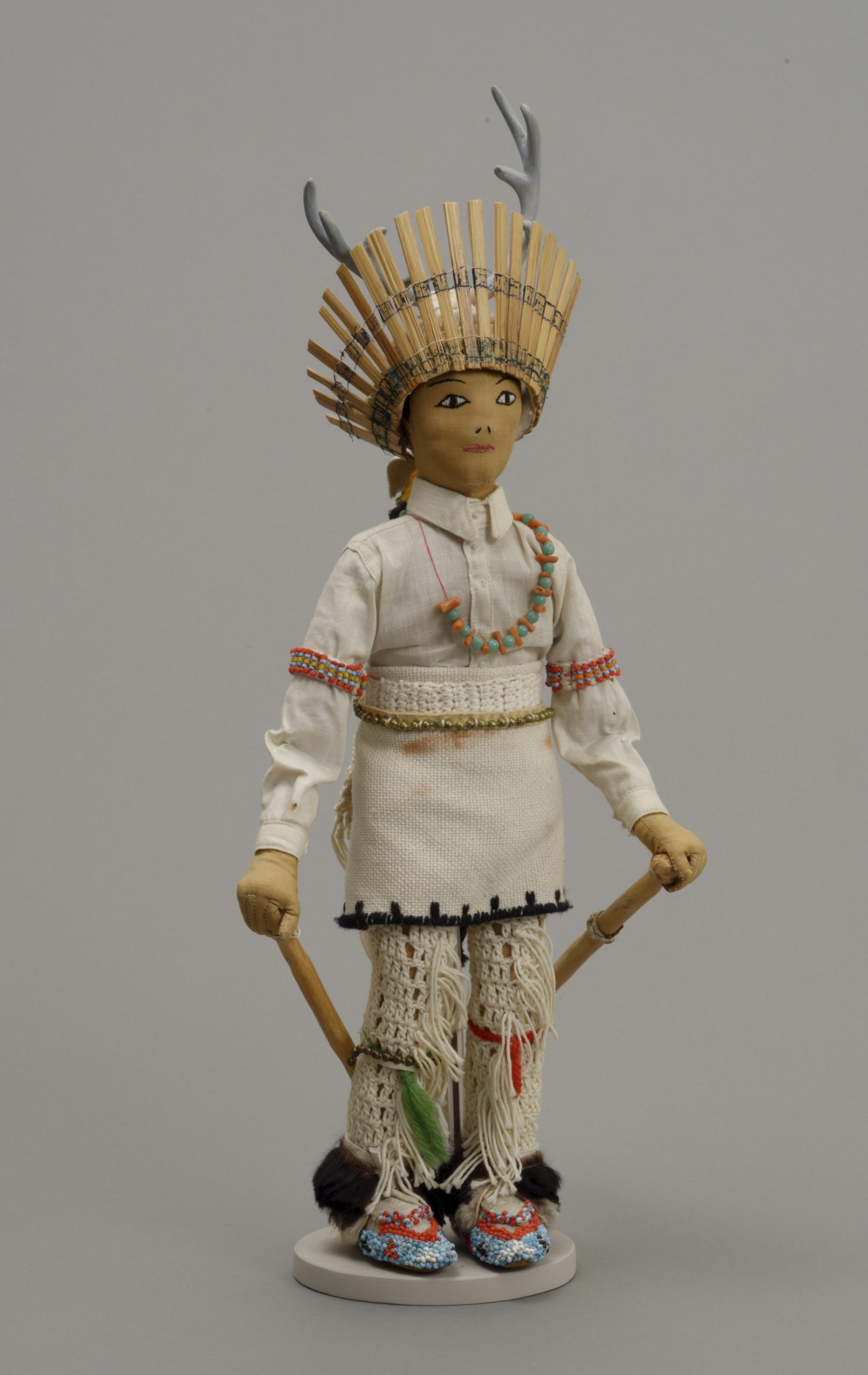San Juan Pueblo (Ohkay-Owingeh), New Mexico (left)
Regina Alvarado Cata, American (San Juan Pueblo [Ohkay-Owingeh], New Mexico), 1890–1971 (right)
Doll representing a San Juan Deer Dancer
- 1946
- Cotton cloth, cotton yarn, wood, buckskin, glass trade beads, fur, brass beads, paint, wool yarn, wool, coral, straight pin, and paint
- 14 9/16 × 4 7/8 × 2 5/8 in.
Hood Museum of Art, Dartmouth College: The Wellington Indian Doll Collection, Gift of Barbara Wellington Wells; 987.35.26768
visibilityLook & DiscussDoll representing a San Juan Basket Dancer
- 1946
- Cloth body, wool, yarn, cotton, buckskin, glass trade beads, sweetgrass, wood, metal, paint, feather, coral, straight pin, sequins, human hair, and ribbon
- 13 × 6 × 4 3/16 in.
Hood Museum of Art, Dartmouth College: The Wellington Indian Doll Collection, Gift of Barbara Wellington Wells; 987.35.267693
San Juan Pueblo doll makers created these exquisite dolls in 1946 to preserve cultural knowledge. The dolls help to preserve cultural history by recreating in exacting detail the clothing required for a male Deer Dance and a female Basket Ceremony. Clothing used in ceremonies must be made correctly. If people forget how to make the clothing, in certain cases, the ceremony cannot take place.
Explore the Object
The male doll is dressed for a ceremony held in the fall before hunting season. Only men can participate in the Deer Dance. He wears a white button-down shirt with glossy white beads to indicate buttons. On his upper arms, he wears beaded buckskin armbands with pine needles tucked in them. He also wears a coral and bead necklace. Around his waist, he wears a woven-cotton ceremonial kilt secured by a crocheted sash and a buckskin belt with a brass bead chain. He also wears crocheted-cotton yarn leggings with fringe down the center. He has a green and red leg band. On his feet, he wears beaded buckskin moccasins with strips of fur dyed black on top and natural on the bottom around his ankles. His wooden strip headdress has been painted with green and blue stripes. On the crown of his head is a rack of deer antlers made of wood. From the back, you can see that the antlers are secured by a buckskin cap with a long flap, which hangs over the man’s wrapped hair. A feather dangles from a ring. Finally, the Deer Dancer holds two sticks that represent the front legs of the deer. During the dance, he uses these to buck and leap like a deer.
This San Juan female figure is dressed to participate in the Basket Dance, one of the few dances in which only women participate. In the Basket Dance ceremony, dancers call upon the gods to bring a bountiful harvest to the San Juan people. She wears a black wool dress that exposes one shoulder. The dress is trimmed with red and yellow yarn running parallel to the hem. Around her waist, she has a woven wool belt in black, white, and red. She has two petticoats under her dress. Around her shoulders, she wears a white woven-cotton mantle embroidered with wool yarn. Her buckskin moccasins have wrapped uppers and a black line around the sole. She wears many necklaces including a triple-strand white bead necklace, a brass bead chain to which is attached a metal cross, and a coral and green bead necklace. In her ears she wears light blue beaded strand earrings. On her left wrist she wears a metal bracelet with a painted stone that represents a turquoise and silver bracelet. A light blue bead signifies a turquoise ring. This Basket Dancer carries a grass basket with a miniature carved bird on a stick.
Regina Alvarado Cata sewed on the facial features of her doll and crocheted the ears. She made the hair from natural fiber, cut it into bangs and parted it into two braids that are pulled up into buns over the doll’s ears. The colors of the clothing represent the cardinal directions. Green represents the north, red the south, white the east, yellow the west, and black the world below.
learn more
Watch Seminole scholar Leah Bowe discuss the clothing and regalia of several Woodlands dolls.
For an excellent teacher resource on Native American dolls, access the Fall 2004 issue of Smithsonian in Your Classroom by the The National Museum of the American Indian.




